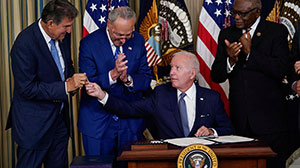Senior Reporter
Inflation Reduction Act Offers Incentives to Increase Electric Truck Adoptions

[Stay on top of transportation news: Get TTNews in your inbox.]
For those motor carriers seeking to begin or continue their fleet conversions to electric trucks, new federal legislation will offer significant financial assistance.
The complex 730-page bill signed into law on Aug. 16, dubbed the Inflation Reduction Act of 2022, includes incentives aimed at significantly accelerating the adoption of zero-emission medium- and heavy-duty trucks and technologies, and funding to fight climate change.
For starters, beginning in 2023, a key provision in the new law will offer purchasers of new medium and heavy electric trucks up to a $40,000 tax credit, and pour billions of dollars into reducing greenhouse gas emissions nationwide — and at many ports. (For electric trucks under 14,000 pounds, and cars, the maximum tax credit is $7,500.)

(Susan Walsh/AP)
READ MORE
There also is a tax credit for qualified investments made in advanced energy projects, including clean vehicles, batteries, EV charging infrastructure and renewable fuels. Those tax credits will be up to 30% for investments made to establish, re-equip, or expand a qualifying manufacturing facility that produces eligible technologies, said Carolyn Berninger, public policy manager for the Great Plains Institute’s transportation and fuels program.
In all, the bill provides roughly $369 billion in incentives for energy and climate-related programs.
“For fleets on the fence as to whether to electrify their power units, the Inflation Reduction Act will assist those companies seeking the financial means to do so,” said Glen Kedzie, vice president and energy and environmental counsel for American Trucking Associations.
But Kedzie cautions that the decision to go electric should not be taken lightly by carriers, and should not be made by a single company department. “You better have the head of your maintenance and fuel folks getting together and talking to utility companies, talking to the OEMs and a lot of different folks before jumping into the water head-first while having no idea how deep the pool is.”
One of the critical considerations for carriers to electrify their fleets will hang on whether charging stations keep up with the growth of vehicle adoptions, Kedzie said.
The trucking industry is generally thought to be supportive of federal legislation’s efforts to help fund the conversion. But that’s not to say that all motor carriers are excited with the notion that regulators in some states will begin the transition to electric vehicles as soon as 2024.
For example, the California Air Resources Board’s Advanced Clean Trucks rule will require truck manufacturers to sell an increasing number of zero-emission trucks starting in 2024, eventually requiring manufacturers to sell 40% to 75% zero-emissions trucks by 2035.
Depending on the specifications and mileage carriers plan to put on a new Class 8 electric truck, the upfront cost could be $300,000 or more, roughly twice the average price of a Class 8 diesel vehicle.
The good news is that experts say the zero-emission trucks will lower operational costs over the years, softening some of the purchase price pain.
With the recent passing of the IRA, #MediumDuty and #HeavyDuty trucks are seeing new tax credits and #grants
The #EV purchase tax credit covers the price difference between a diesel truck and the #electric counterpart, or 30% of the truck’s purchase pricehttps://t.co/2ZyQ4gPIoh pic.twitter.com/MXJ2cLaxJi — CALSTART (@CALSTART) August 18, 2022
Calstart, a national nonprofit that focuses on key activities to accelerate clean technologies, lauded Congress for passage of the bill. “We celebrate the inclusion of the clean vehicle credit, the credit for previously owned vehicles, the new credit for qualified commercial vehicles, and the advanced manufacturing production credit, which includes a significant production tax credit for battery manufacturing,” Calstart said in a statement.
Most major U.S. original equipment manufacturers have goals to reduce the majority of or eliminate fossil fuel-powered vehicles from their fleets by 2040-2050, according to a Calstart report issued earlier this year.
Want more news? Listen to today's daily briefing above or go here for more info
“There is a good amount of money to help cover the cost for zero-emission trucks for the upfront purchase cost,” Paul Miller, executive director of Northeast States for Coordinated Air Use Management (NESCAUM), told Transport Topics. “That’s been one of the obstacles up front for the relatively higher purchase cost. But operationally, we believe they are cheaper to run in terms of maintenance and fuel costs, over the long run.”
NESCAUM is the regional association of state air pollution control agencies in Connecticut, Maine, Massachusetts, New Hampshire, New Jersey, New York, Rhode Island and Vermont. Its goal is to make 100% of sales of new medium and heavy trucks zero-emission vehicles by no later than 2050, and at least 30% of sales by 2030.
“This is a case of the government taking on some of the risk in the new technology development where private companies don’t want to take on that risk,” Miller said. “Then as the technology matures, the need for these incentives goes away.”
The SAF tax credit, without parity for other fuels, will undermine America's access to #biofuels which have been an essential tool in reducing #emissions on our roads since 2005. Learn more: https://t.co/aguyvcOGGn pic.twitter.com/KVLAmtrvB9 — NATSO, Inc. (@NATSO_Inc) August 5, 2022
Natso, an Alexandria, Va.-based association representing the truck stop and travel plaza industry, opposed the bill.
“While it makes sense for fuel technologies to earn favorable tax treatment through tangible reductions in carbon emissions, this bill gives aviation fuel more favorable treatment without having to demonstrate improved environmental benefits,” Natso Executive Vice President of Government Affairs David Fialkov said in a statement.
“The diversion of investment away from renewable diesel will increase retail diesel prices,” he added. “Rather than reducing inflation, this legislation will increase the price of all consumer goods hauled by truck.”




